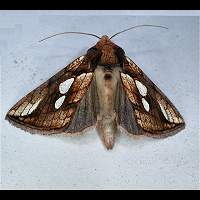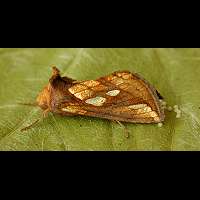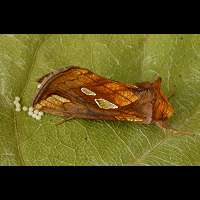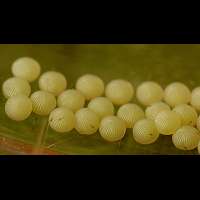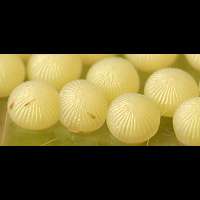[All pictures of garden wildlife on this page are thumbnails. Click on any thumbnail for a large format to be displayed.]

Gold Spot (Plusia festucae)
| Taxonomy | ||||||
|---|---|---|---|---|---|---|
| Kingdom: | Phylum: | Class: | Order: | Family: | Genus: | Species: |
| Animalia | Arthropoda | Insecta | Lepidoptera | Noctuidae | Plusia | P.festucae |
The Gold Spot is a rather small, but extremely beautiful Noctuid. You may be thinking it probably is unique, but it isn't. It has a twin brother: Lempke's Gold Spot. Experts can tell you the difference immediately by looking at the shape of the wing. The Gold Spot has longer and smaller wings. There is another way though. Both species have a series of silver spots near the wing tip. The upper spot is a long line ending in a sharp angle in the Gold Spot, but the spot is shorter and ending bluntly in Lempke's Gold Spot. The Gold Spot has a variable wingspan, which ranges from 34 to 46 mm.
The second brood deposits its eggs in July and August. They hatch in September. The caterpillars don't grow much and overwinter while still being very small. After overwintering they grow much faster and pupate in April or May. For this purpose they spin a very strong cocoon which is attached to leaves. The caterpillar of the Gold Spot is green and relatively slim. There are six thin yellowish dorsal lines, even though all may not be visible at a given time. On the side runs a thick yellowish line. The head is green. There are no prolegs on segments 6 and 7. Foodplants are grasses, sedges, yellow iris and reet. The larvae reach a length of some 36 to 43 mm. The larvae of the Gold Spot and Lempke's Gold Spot are absolutely identical.
The Gold Spot is double-brooded in Southern Britain. The small first generation is on the wing in May and the beginning of June. The second generation is much more numerous and flies about in July and August. In Northern Britain there is one brood only, on the wing from June to August. Frequent visitor to gardens where it is seen sucking nectar from valerian, water-mint and Buddleija, usually by night, but quite often also during the day. Quite easy to photograph, but may take off unexpectedly. Comes to light in very small numbers only. This species prefers damp places and is common at such places all over Europe, including most of Britain.

© Copyright 1998-2024 gardensafari.net (Hania Berdys)

 English / engels
English / engels  Dutch / nederlands
Dutch / nederlands